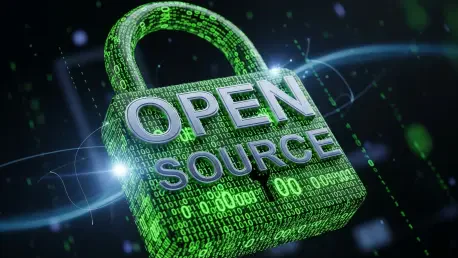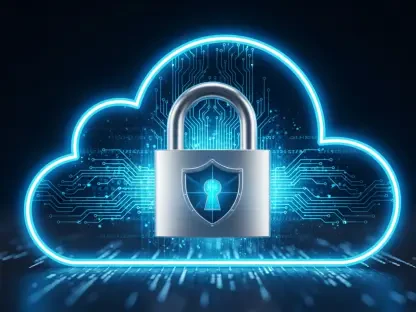Introduction to a Growing Challenge
In today’s enterprise IT landscape, open-source software powers an estimated 90% of modern applications, forming the backbone of critical infrastructure across industries. However, with this widespread adoption comes a pressing challenge: securing software that has reached end-of-life (EOL) status, leaving organizations vulnerable to cyber threats without vendor support. This vulnerability gap poses significant risks, from data breaches to operational disruptions, as companies grapple with the high costs of upgrades or system overhauls. TuxCare, a leader in enterprise-grade cybersecurity, steps into this arena with its Endless Lifecycle Support (ELS), offering a lifeline to businesses reliant on outdated open-source technologies. This report delves into how TuxCare’s innovative approach addresses these security concerns and reshapes the management of open-source ecosystems.
The Open-Source Software Environment Today
Open-source software has become indispensable in enterprise settings, driving innovation in sectors ranging from finance to healthcare. Its flexibility and cost-effectiveness have led to near-universal adoption, with platforms like Linux, Apache, and various programming libraries forming the core of IT systems worldwide. However, the rapid pace of development often leaves older versions unsupported, creating a security blind spot that cybercriminals are quick to exploit. Key ecosystems such as Java, JavaScript, and Python dominate the landscape, with millions of applications depending on their frameworks and libraries for functionality.
Major players like TuxCare have emerged as critical allies in this space, providing solutions tailored to the unique challenges of open-source security. The growing emphasis on cybersecurity reflects a broader industry trend, as businesses recognize that unprotected software can lead to catastrophic breaches. This reality underscores the need for specialized support services that extend beyond traditional vendor timelines, ensuring that even EOL components remain secure.
Beyond individual organizations, the collective reliance on open-source technologies amplifies the stakes, as vulnerabilities in widely used libraries can impact entire industries. TuxCare’s role in this ecosystem is not just reactive but proactive, addressing risks before they materialize into threats. This shift toward preventive security measures marks a significant evolution in how enterprises approach their IT infrastructure management.
TuxCare’s Endless Lifecycle Support Expansion
Core Offerings and Covered Technologies
TuxCare’s recent expansion of its Endless Lifecycle Support portfolio, announced on November 11, 2025, marks a pivotal advancement in open-source security. This update extends coverage to 15 essential libraries, frameworks, and runtimes across major ecosystems, including JavaScript components like Bootstrap, NodeJS, and jQuery; Java tools such as Jackson and Apache Commons Lang; and Python resources like Flask, Django, and NumPy. This broad spectrum ensures that organizations using diverse tech stacks can benefit from sustained protection long after official support ends.
The ELS program offers several standout features designed to bolster security without disrupting operations. Rapid, SLA-backed patches address vulnerabilities swiftly, while coverage of both direct and transitive dependencies eliminates hidden risks at no additional cost. Integration with existing tools streamlines implementation, and 24/7 global support provides round-the-clock assistance, catering to businesses operating in multiple time zones.
This comprehensive suite of services reflects TuxCare’s understanding of the intricate dependencies within open-source environments. By supporting multiple versions of critical software, the company ensures that even legacy systems remain shielded from emerging threats. Such an approach is particularly valuable for enterprises that cannot immediately transition to newer software due to compatibility or budgetary constraints.
Industry Influence and Enterprise Advantages
The expansion of ELS addresses a critical market need: securing EOL software without the prohibitive costs of upgrades or complete system rebuilds. Many organizations delay updates due to the complexity and expense involved, leaving their systems exposed to exploitation. TuxCare’s solution fills this gap by providing ongoing security updates, allowing businesses to maintain stability while planning long-term transitions.
Michael Canavan, Chief Revenue Officer at TuxCare, highlighted the dual advantage of this offering, emphasizing that it delivers both enhanced security and operational flexibility. This balance is crucial for IT teams managing tight budgets and for leadership seeking to minimize risk without sacrificing efficiency. The impact resonates across organizational levels, enabling smoother operations and stronger defenses against cyber threats.
Furthermore, this initiative reduces the pressure on enterprises to rush into costly migrations, offering a sustainable path to security. By extending the usable life of software, TuxCare empowers companies to allocate resources more effectively, focusing on innovation rather than emergency fixes. This strategic benefit positions the ELS program as a game-changer in the open-source security domain.
Navigating Security Hurdles in Open-Source Ecosystems
Securing open-source software, particularly EOL components, presents a complex challenge for enterprises. Without ongoing vendor support, vulnerabilities can go unpatched, creating entry points for cyberattacks that jeopardize sensitive data and critical operations. The financial burden of overhauling systems to newer versions often deters timely action, exacerbating these risks over time.
TuxCare tackles these obstacles by offering a practical alternative that mitigates threats without necessitating immediate, disruptive changes. Its ELS program delivers targeted patches and updates, ensuring that even outdated software remains protected against known exploits. This approach minimizes downtime and preserves operational continuity, addressing a core pain point for IT departments.
Additionally, the solution helps organizations avoid the reputational and financial fallout of security breaches. By proactively managing risks associated with EOL software, TuxCare enables businesses to maintain customer trust and operational integrity. This focus on prevention rather than reaction sets a new standard for managing open-source security challenges in a dynamic threat landscape.
Compliance and Security Standards in Open-Source Contexts
The regulatory environment surrounding open-source software continues to tighten, with industries facing stringent requirements to safeguard data and systems. Standards such as GDPR, HIPAA, and PCI DSS demand robust security measures, even for software no longer supported by original vendors. Non-compliance can result in severe penalties, making adherence a top priority for enterprises globally.
TuxCare’s ELS aligns seamlessly with these compliance needs by ensuring that supported software remains secure and up-to-date with industry benchmarks. This alignment helps organizations avoid legal and financial repercussions while maintaining trust with stakeholders. The program’s comprehensive coverage addresses the nuances of regulatory demands across different sectors.
Moreover, by integrating security with compliance, TuxCare offers a holistic solution that simplifies audits and reporting processes. Enterprises can demonstrate due diligence in protecting their IT environments, a critical factor in regulated industries. This synergy between security and compliance underscores the value of extended support in navigating the complex landscape of open-source governance.
Looking Ahead at Open-Source Security Trends
As reliance on open-source software grows, so does the demand for innovative security solutions that adapt to evolving threats. Emerging trends point to an increased focus on extended support services, with more organizations seeking ways to protect legacy systems without immediate upgrades. This shift reflects a broader recognition of the long-term value of sustainable IT strategies.
Potential advancements in vulnerability management, such as AI-driven threat detection and automated patching, are poised to redefine the field over the next few years, from 2025 to 2027. TuxCare’s proactive stance positions it well to incorporate such innovations, ensuring that its offerings remain at the forefront of industry developments. Balancing cutting-edge technology with risk mitigation will be key to future success.
Additionally, the growing complexity of cyber threats necessitates a forward-thinking approach to security. TuxCare’s commitment to addressing both current and anticipated challenges suggests a trajectory of continued relevance. By fostering secure, sustainable IT environments, the company is likely to play a pivotal role in shaping the next era of open-source protection.
Reflecting on Findings and Next Steps
Looking back, TuxCare’s expansion of its Endless Lifecycle Support emerged as a vital response to the persistent security gaps in open-source software, providing a lifeline for enterprises burdened by EOL challenges. The initiative stood out for its comprehensive coverage across diverse ecosystems, ensuring that critical components remained protected against evolving threats. This strategic move redefined how organizations approached the management of outdated technologies.
Moving forward, businesses are encouraged to evaluate their reliance on unsupported software and consider extended support as a cost-effective alternative to immediate upgrades. Partnering with providers like TuxCare offers a pathway to bolster security without straining resources, a practical step for maintaining operational resilience. Exploring such solutions becomes essential for staying ahead in an increasingly complex cyber landscape.
Lastly, the industry is prompted to prioritize long-term security planning, integrating extended lifecycle support into broader IT strategies. This proactive mindset promises to mitigate risks while fostering innovation, ensuring that enterprises can navigate future uncertainties with confidence. The focus shifts toward building partnerships and adopting scalable solutions to safeguard open-source environments for years to come.









